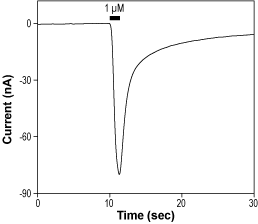Overview
Cat #:
A-480
Lyophilized Powder yes
Source Synthetic
MW: 228.25
Purity: >96%
Effective concentration 0.5-50 µM.
Chemical name 2-azaniumyl-3-(5-tert-butyl-3-oxo-1,2-oxazol-4-yl)propanoate.
Molecular formula C10H16N2O4.
CAS No.: 140158-50-5
PubChem CID 2253
Activity ATPA is a potent and selective agonist of GluR5 kainate receptor (EC50 = 0.66 µM), inactive on GluR6 and less active on other kainate receptor subtypes. It is also a significantly weaker agonist of AMPA receptors (EC50 = 8 µM-62 µM, depending on subtype)1,2.
References-Activity
- Nielsen, M.M. et al. (2003) Mol. Pharmacol. 63, 19.
- Traynelis, S.F. et al. (2010) Pharmacol. Rev. 62, 405.
Shipping and storage Shipped at room temperature. Product as supplied can be stored intact at room temperature for several weeks. For longer periods, it should be stored at +4°C.
Solubility Soluble in water, DMSO and 1eq NaOH. Centrifuge all products before handling (10000 x g 5 min).
Storage of solutions Store at -20°C. It is recommended to prepare solutions afresh on the day of use, or aliquot stock solutions stored at -20°C to prevent repeated thawing and freezing.
Our bioassay
References - Scientific background
- Nielsen, M.M. et al. (2003) Mol. Pharmacol. 63, 19.
- Traynelis, S.F. et al. (2010) Pharmacol. Rev. 62, 405.
- Figueiredo, T.H. et al. (2011) J. Pharmacol. Exp. Ther. 336, 303.
Scientific background
ATPA, an AMPA derivative, is a potent and selective agonist of the GluR5 (GluK1) kainate receptor subtype, with an EC50 value of 0.66 µM1. ATPA is less active towards other kainate receptor subtypes and is inactive towards GluR6. The compound also shows weak agonistic activities towards AMPA receptors1,2. Studies show that ATPA can induce clonic seizures when infused intravenously or directly into the rat amygdala3.
GluR5 containing kainate receptors play an important role in the regulation of GABA(A) receptor-mediated inhibitory transmission in the hippocampus and in the amygdala3.
Target GluK1 (GluR5) kainate receptors
Lyophilized Powder
ATPA (#A-480) is a highly pure, synthetic, and biologically active compound.
For research purposes only, not for human use
Last Update: 07/05/2024
Applications
Citations
Citations


